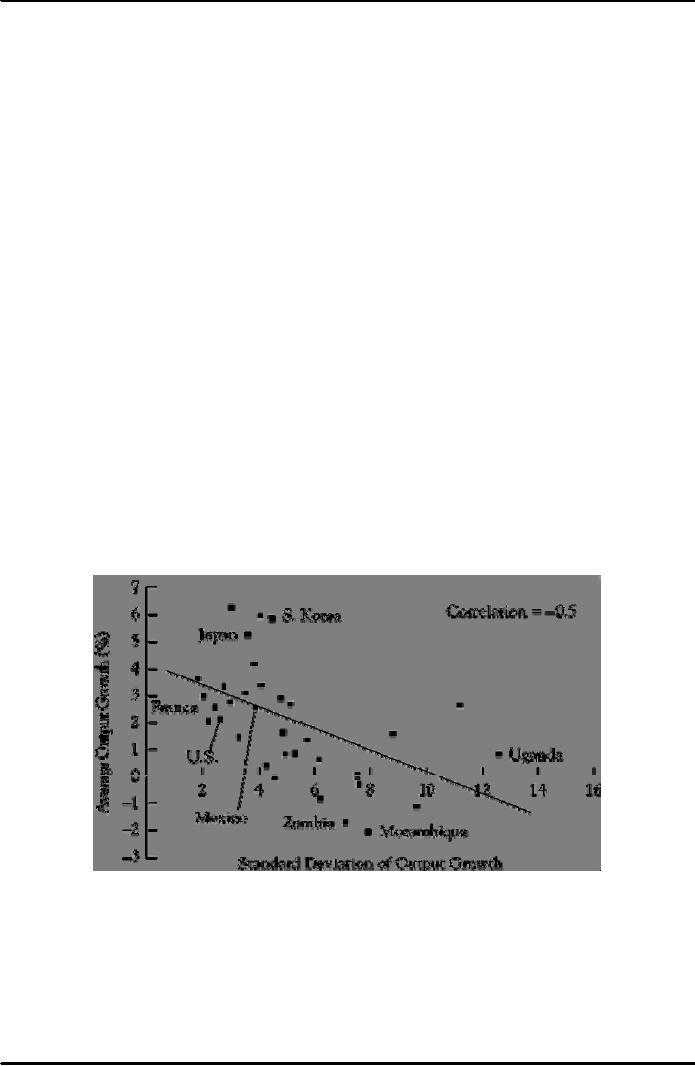 |
LOW, STABLE INFLATION:High, Stable Real Growth |
| << THE GOVERNMENT'S BANK:The Bankers' Bank, Low, Stable Inflation |
| MEETING THE CHALLENGE: CREATING A SUCCESSFUL CENTRAL BANK >> |

Money
& Banking MGT411
VU
Lesson
31
LOW,
STABLE INFLATION
Many
central banks take as their
primary job the maintenance of price
stability; they strive
to
eliminate
inflation.
The
rationale for keeping the economy
inflation-free is that money's
usefulness as a unit of
account
and as a store of value is
enhanced when its purchasing
power is maintained.
Inflation
degrades the information content of
prices and impedes the market's
function of
allocating
resources to their best
uses.
The
higher the inflation is, the less
predictable it is, and the more
systematic risk it
creates.
Also,
high inflation is bad for
growth.
While
there is agreement that low
inflation should be the primary
objective of monetary
policy,
there
is no agreement on how low
inflation should be.
Zero
inflation is too low,
because it brings the risk of
deflation (a drop in prices) which in
turn
results
in increased defaults on loans and a
threat to the health of banks.
Furthermore,
if inflation were zero, an employer
wishing to cut labor costs
would need to cut
nominal
wages, which is difficult to
do.
A
small amount of inflation
may actually make labor
markets work better, at
least from the
employer's
point of view.
High,
Stable Real Growth
Central
bankers work to dampen the
fluctuations of the business cycle;
booms are popular
but
recessions
are not.
Central
bankers work to moderate
these cycles and stabilize
growth and employment by
adjusting
interest rates.
Monetary
policymakers can moderate
recessions by lowering interest rates and
can moderate
booms
by raising them (to keep growth at a
sustainable level).
Along
with growth and employment,
stability is also important,
because fluctuations in general
business
conditions are the primary
source of systematic
risk.
Financial
System Stability
Financial
system stability is an integral
part of every modern central
banker's job.
The
possibility of a severe disruption in the
financial markets is a type of
systematic risk that
central
banks must control.
Interest
Rate and Exchange Rate
Stability
Interest
rate stability and exchange rate
stability are a means for
achieving the ultimate goal
of
stabilizing
the economy; they are not
ends unto themselves.
96

Money
& Banking MGT411
VU
Interest
rate volatility is a problem
because:
it
makes output unstable as borrowing and
expenditure fluctuate with
changing rates.
it
means higher risk and a
higher risk premium and
makes financial decisions more
difficult.
Even
though the exchange rate affects the
prices of imports and exports,
stabilizing exchange
rates
is the last item on the list of central
bank objectives.
Different
countries have different priorities when
it comes to the exchange rate;
Stable
exchange rates are more
important in developing countries because
imports and exports
are
central to their
economies.
The
objectives of a Modern Central
Bank
Inflation
creates confusion and makes
planning difficult.
When
Low
Stable Inflation
inflation
is high, growth is
low
Stable
predictable growth is higher
than unstable, unpredictable
High
Stable growth
growth
A
stable financial system is
necessity for an economy to
operate
Financial
System
efficiently
Stability
Interest
rate volatility creates risk
for both lenders and
borrowers
Stable
Interest Rates
Stable
Exchange Rates Variable
exchange rates make the revenues from
foreign sales and the
cost
of purchasing imported goods hard to
predict
Meeting
the Challenge: Creating a Successful
Central Bank
The
boom in the past decade with
its associated decrease in
volatility may have
happened
because
technology sparked a boom
just as central banks became
better at their jobs.
Policymakers
realized that sustainable growth had gone
up, so interest rates could be
kept low
without
worrying about inflation,
and central banks were
redesigned.
Today
there is a clear consensus about the best
way to design a central bank and
what to tell
policymakers
to do.
A
central bank must be
Independent
of political pressure,
Accountable
to the public,
Transparent
in its policy actions,
Clear
in its communications with financial
markets and the public
97
Table of Contents:
- TEXT AND REFERENCE MATERIAL & FIVE PARTS OF THE FINANCIAL SYSTEM
- FIVE CORE PRINCIPLES OF MONEY AND BANKING:Time has Value
- MONEY & THE PAYMENT SYSTEM:Distinctions among Money, Wealth, and Income
- OTHER FORMS OF PAYMENTS:Electronic Funds Transfer, E-money
- FINANCIAL INTERMEDIARIES:Indirect Finance, Financial and Economic Development
- FINANCIAL INSTRUMENTS & FINANCIAL MARKETS:Primarily Stores of Value
- FINANCIAL INSTITUTIONS:The structure of the financial industry
- TIME VALUE OF MONEY:Future Value, Present Value
- APPLICATION OF PRESENT VALUE CONCEPTS:Compound Annual Rates
- BOND PRICING & RISK:Valuing the Principal Payment, Risk
- MEASURING RISK:Variance, Standard Deviation, Value at Risk, Risk Aversion
- EVALUATING RISK:Deciding if a risk is worth taking, Sources of Risk
- BONDS & BONDS PRICING:Zero-Coupon Bonds, Fixed Payment Loans
- YIELD TO MATURIRY:Current Yield, Holding Period Returns
- SHIFTS IN EQUILIBRIUM IN THE BOND MARKET & RISK
- BONDS & SOURCES OF BOND RISK:Inflation Risk, Bond Ratings
- TAX EFFECT & TERM STRUCTURE OF INTEREST RATE:Expectations Hypothesis
- THE LIQUIDITY PREMIUM THEORY:Essential Characteristics of Common Stock
- VALUING STOCKS:Fundamental Value and the Dividend-Discount Model
- RISK AND VALUE OF STOCKS:The Theory of Efficient Markets
- ROLE OF FINANCIAL INTERMEDIARIES:Pooling Savings
- ROLE OF FINANCIAL INTERMEDIARIES (CONTINUED):Providing Liquidity
- BANKING:The Balance Sheet of Commercial Banks, Assets: Uses of Funds
- BALANCE SHEET OF COMMERCIAL BANKS:Bank Capital and Profitability
- BANK RISK:Liquidity Risk, Credit Risk, Interest-Rate Risk
- INTEREST RATE RISK:Trading Risk, Other Risks, The Globalization of Banking
- NON- DEPOSITORY INSTITUTIONS:Insurance Companies, Securities Firms
- SECURITIES FIRMS (Continued):Finance Companies, Banking Crisis
- THE GOVERNMENT SAFETY NET:Supervision and Examination
- THE GOVERNMENT'S BANK:The Bankers' Bank, Low, Stable Inflation
- LOW, STABLE INFLATION:High, Stable Real Growth
- MEETING THE CHALLENGE: CREATING A SUCCESSFUL CENTRAL BANK
- THE MONETARY BASE:Changing the Size and Composition of the Balance Sheet
- DEPOSIT CREATION IN A SINGLE BANK:Types of Reserves
- MONEY MULTIPLIER:The Quantity of Money (M) Depends on
- TARGET FEDERAL FUNDS RATE AND OPEN MARKET OPERATION
- WHY DO WE CARE ABOUT MONETARY AGGREGATES?The Facts about Velocity
- THE FACTS ABOUT VELOCITY:Money Growth + Velocity Growth = Inflation + Real Growth
- THE PORTFOLIO DEMAND FOR MONEY:Output and Inflation in the Long Run
- MONEY GROWTH, INFLATION, AND AGGREGATE DEMAND
- DERIVING THE MONETARY POLICY REACTION CURVE
- THE AGGREGATE DEMAND CURVE:Shifting the Aggregate Demand Curve
- THE AGGREGATE SUPPLY CURVE:Inflation Shocks
- EQUILIBRIUM AND THE DETERMINATION OF OUTPUT AND INFLATION
- SHIFTS IN POTENTIAL OUTPUT AND REAL BUSINESS CYCLE THEORY